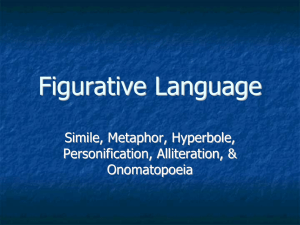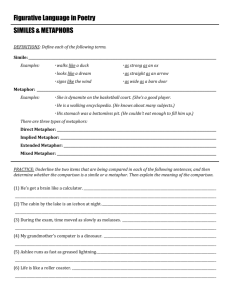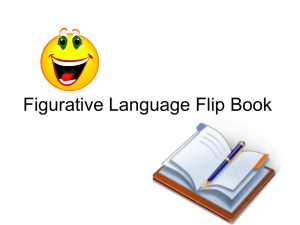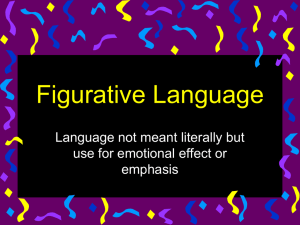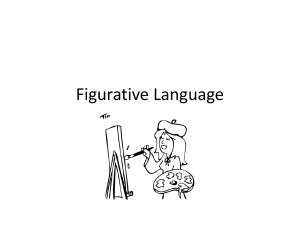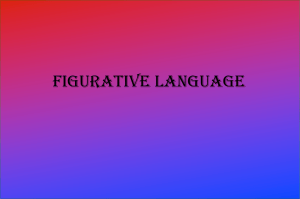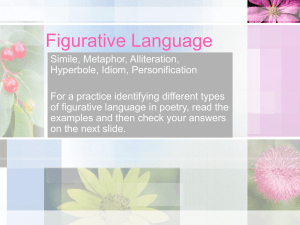File
advertisement
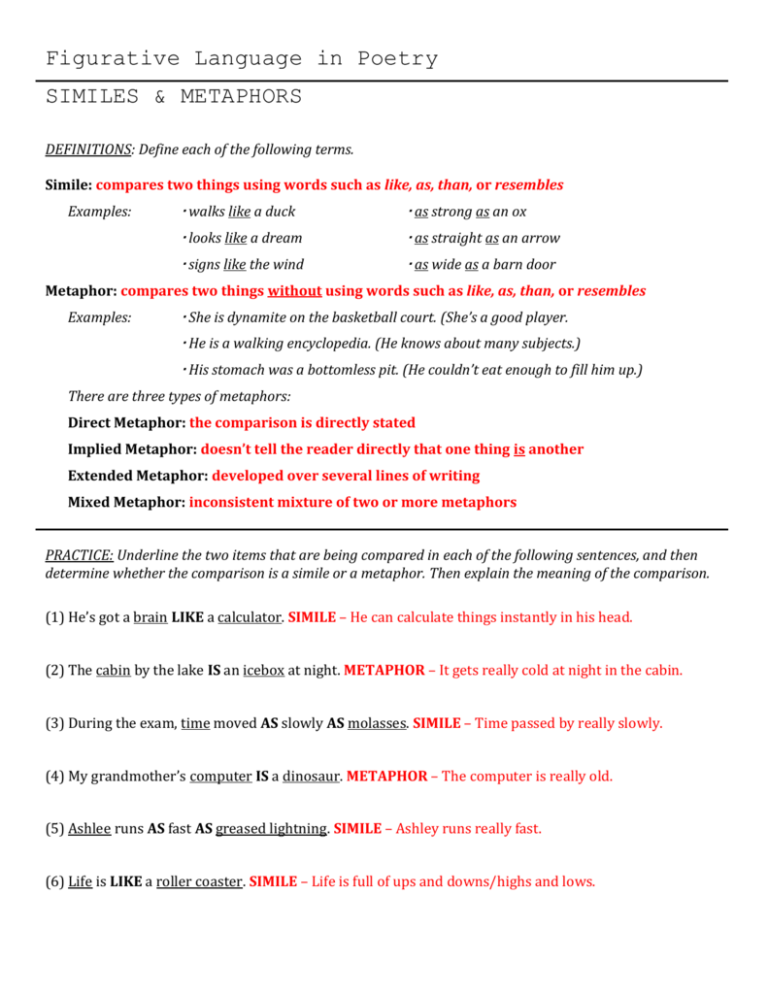
Figurative Language in Poetry SIMILES & METAPHORS DEFINITIONS: Define each of the following terms. Simile: compares two things using words such as like, as, than, or resembles Examples: walks like a duck as strong as an ox looks like a dream as straight as an arrow signs like the wind as wide as a barn door Metaphor: compares two things without using words such as like, as, than, or resembles Examples: She is dynamite on the basketball court. (She’s a good player. He is a walking encyclopedia. (He knows about many subjects.) His stomach was a bottomless pit. (He couldn’t eat enough to fill him up.) There are three types of metaphors: Direct Metaphor: the comparison is directly stated Implied Metaphor: doesn’t tell the reader directly that one thing is another Extended Metaphor: developed over several lines of writing Mixed Metaphor: inconsistent mixture of two or more metaphors PRACTICE: Underline the two items that are being compared in each of the following sentences, and then determine whether the comparison is a simile or a metaphor. Then explain the meaning of the comparison. (1) He’s got a brain LIKE a calculator. SIMILE – He can calculate things instantly in his head. (2) The cabin by the lake IS an icebox at night. METAPHOR – It gets really cold at night in the cabin. (3) During the exam, time moved AS slowly AS molasses. SIMILE – Time passed by really slowly. (4) My grandmother’s computer IS a dinosaur. METAPHOR – The computer is really old. (5) Ashlee runs AS fast AS greased lightning. SIMILE – Ashley runs really fast. (6) Life is LIKE a roller coaster. SIMILE – Life is full of ups and downs/highs and lows. Figurative Language in Poetry PERSONIFICATION & HYPERBOLES DEFINITIONS: Define each of the following terms. Personification: when nonhuman things are given human qualities Examples: Lightning danced across the sky. (Lightning lit the entire sky up.) Fear knocked on the door. (Fear was very close.) The wind whispered softly in the night. (The wind softly blew.) Hyperbole: an exaggeration used to express strong emotion or to create a comedic effect Examples: That textbook weighs a ton. (The textbook is heavy.) I could sleep for a year. (I am very tired.) I’ve told you a million times to stop lying! (I’ve told you a lot of times to stop lying.) PRACTICE: Determine whether each of the following statements is an example of personification or a hyperbole. Then explain the meaning of that figure of speech. (1) The big full moon guided me through the forest. PERSONIFICATION – The moon gave off enough light to see and get through the forest. (2) The old car groaned as it made its way down the long open road. PERSONIFICATION – The car made a loud noise as it traveled down the road. (3) When someone volunteers to do community service, he/she becomes a superhero. HYPERBOLE – People really look up to and respect volunteers. (4) The leaves raced to the ground as the children ran across the playground. PERSONIFICATION – The leaves fell quickly to the ground. (5) Her explanation was as clear as mud. HYPERBOLE – Her explanation was very unclear and hard to understand. (6) I will die if he asks me to dance! HYPERBOLE – I will be so embarrassed OR nervous if he asks me to dance. (7) The camera absolutely loves Anna. PERSONFICATION – Anna takes really good pictures. (8) Our star athlete is as fast as lighting. HYPERBOLE – The athelete is really fast. (9) When we returned from our vacation, it was obvious that our flowers were begging for water. PERSONIFICATION – The flowers needed water badly; they were on the verge of dying. Figurative Language in Poetry PUNS & ONOMATOPOEIAS DEFINITIONS: Define each of the following terms. Pun: a play on the multiple meanings of one or two words that sound alike by have different meanings Examples: I work as a baker because I knead dough. The difference between a conductor and a teacher is that the conductor minds the train, and a teacher trains the mind. Seen on a plumber’s truck: “A flush beats a full house!” Onomatopoeia: a word whose sound imitates or suggests its meaning Examples: Listen to the bee buzz by. “Cock-a-doodle-doo!” cried the rooster. The clock goes “tick-tock.” PRACTICE: Underline the word that the pun focuses on. Then explain the pun on the line provided. (1) I recently spent money on a substance to unclog my kitchen sink. It was just money down the drain. -The substance must go down the drain, and the phrase means losing money. (2) Our social studies teacher says that her globe means the world to her. -A globe is a physical representation of the world. (3) A dog not only has a fur coat but also pants. -“Pants” refers to the way the dog is breathing, not a pair of pants. (4) Sir Lancelot once had a very bad dream about his horse. It was a knight mare. -Sir Lancelot is a knight; a female horse is called a mare. (5) Corduroy pillows are making headlines. -Corduroy has lines, so resting on a corduroy pillow would produce lines on your head. PRACTICE: Underline the onomatopoeia in each of the following sentences. (1) Don't beep that horn again. (4) Drip, drip, drip, went the faucet all day long. (2) The pig squealed. (7) Baa, baa wailed the sheep. Figurative Language in Poetry ALLITERATION & ASSONANCE DEFINITIONS: Define each of the following terms. Alliteration: the repetition of the same or similar consonant sounds in words close together. Examples: Benjamin Barker loves to bake buns and biscuits and buttery cakes. Phyllis is a famous photographer. The sun sizzled the swimmer’s skin. Assonance: the repetition of similar vowel sounds in words close together. Examples: Anna’s nanna asked for bananas and apples. I made my way to the lake. Little kids will throw big fits. PRACTICE: Determine whether each sentence or stanza contains examples of alliteration or assonance. Then underline the letter(s) that exemplify that. (1) assonance And so, all the night-tide, I lie down by the side Of my darling, my darling, my life and my bride. (2) assonance Hear the mellow wedding-bells/Golden bells! (3) alliteration And the silken, sad, uncertain rustling of each purple curtain Thrilled me — filled me with fantastic terrors never felt before… (4) assonance And the Raven, never flitting, still is sitting, still is sitting (5) alliteration Whereat, with blade, with bloody blameful blade, He bravely breach'd his boiling bloody breast. (6) SKIP Season of mists and mellow fruitfulness, Close bosom friend to the maturing sun, Conspiring with him how to load and bless With fruit the vines that round the thatch-eaves run (7) alliteration …sidelong flowing flakes that flock, pause, and renew and sinister and furtive: Pale flakes with fingering stealth come feeling for our faces Figurative Language in Poetry IDIOMS, PARADOXES & OXYMORONS DEFINITIONS: Define each of the following terms. Idiom: an expression that means something different from its literal meaning Examples: She really has a chip on her shoulder. (She’s upset about something. Missing the bus was a blessing in disguise. (Something good that wasn’t seen at first.) That test was a piece of cake. (It was very easy.) Paradox: a statement or situation that seems to be a contradiction but reveals a truth Examples: Jim and Della were one of the richest couples on earth. (from “The Gift of the Magi”) War is peace. Freedom is slavery. Ignorance is strength. (from 1984 by George Orwell) Oxymoron: when opposite ideas are combined Examples: Good grief! A definite maybe Terribly pleased Jumbo shrimp PRACTICE: Underline the idiom in each of the following sentences, and then explain the meaning of each idiom. (1) Ross received a slap on the wrist for fighting at school. He didn’t receive harsh punishment. (2) I believe that one day you will get a dose of your own medicine. You’ll get the same treatment you give others. (3) Sometimes your actions speak louder than your words. What you do says more about you than what you say about yourself. (4) All Fran ever does is add fuel to the fire. Fran makes things worse. (5) Everyone says that Jerry is all bark and no bite. Jerry acts tough, but he’s really not. PRACTICE: Explain each of the following paradoxes. (1) Ignorance is bliss. Sometimes not knowing something keeps a person happier because knowledge about something can change the way you feel (2) What a pity that youth must be wasted on the young. Older people realize how valuable a person’s youth is, whereas the young of today don’t take advantage of the opportunities youth provides a person. PRACTICE: Explain why each of the following phrases is an oxymoron. (1) a genuine imitation Something genuine is one-of-a-kind; an imitation is a duplicate of something. (2) just act naturally Acting requires one to pretend, which is the opposite of being natural. (3) a small crowd A crowd is a large group; large is the opposite of small.

